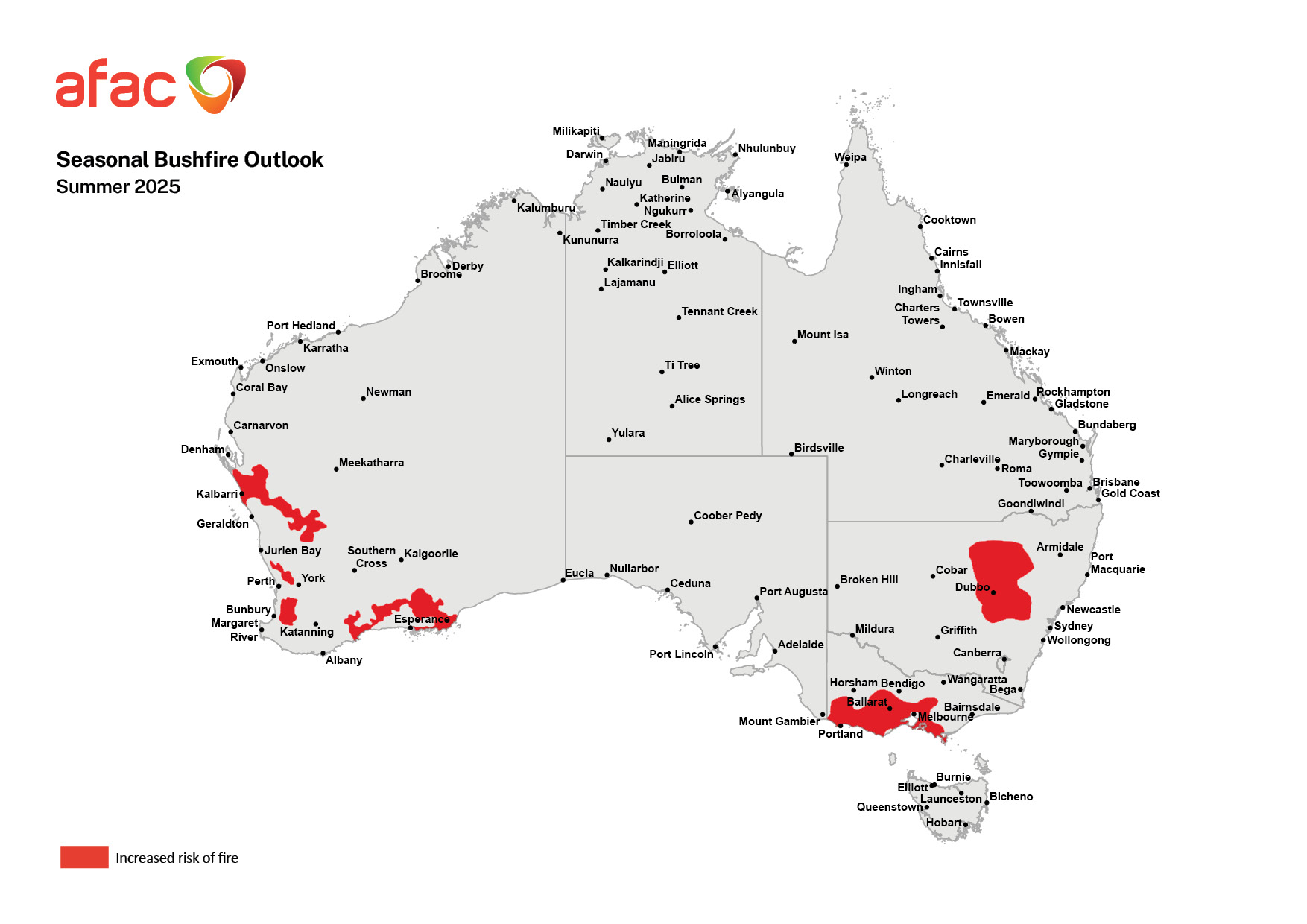Seasonal Bushfire Outlook Summer 2025
The Seasonal Bushfire Outlook for summer 2025-26 identifies a heightened risk of fire for regions in western and southern Western Australia and parts of central northern New South Wales. An increased risk of fire is also forecast for the south-west, western, central and north-central Victoria, as well as south-west Gippsland.
The increased bushfire risk potential is driven in part by severe rainfall deficits across parts of Victoria, along with high fuel loads in central northern NSW and the Yalgoo and the Geraldton Sandplains regions in WA. Persistent soil moisture deficits in parts of WA are driving increased bushfire risk in northern parts of the Swan Coastal Plain, Jarrah Forest, Esperance Plains, and Mallee regions.
Long-term rainfall deficiencies persist in southern South Australia, Victoria, Tasmania, and western WA.

AFAC CEO Rob Webb said: “Australia’s climate and vegetation varies greatly and it’s vital to have experts from our fire services working hand in hand with climate experts from the Bureau. They leave no stone unturned to provide the best possible information.”
“Australia is a great place to be in summer but no matter where you live or travel this season, everyone can play an important role in bushfire safety by being prepared and staying alert to warnings and advice. Your local fire agency is the perfect place to find out exactly how to stay safe this summer.”
"Local fire authorities will be monitoring bushfire risk this season so you can stay up to date and ready to act if there is an emergency.
The Bureau of Meteorology report that for much of Australia, the forecast signal for December to February rainfall is weak, meaning there is roughly an equal chance of above or below average rainfall. Below average rainfall is likely for northern parts of WA, and some inland parts of the east. Chances of above average rainfall have generally decreased over recent forecasts, with a dry signal now more pronounced for the month of December.
Above average sea surface temperatures persist around much of the Australian coastline providing increased moisture and energy that can enhance the severity of storms and weather systems. December to February is likely to experience above average daytime temperatures for most of Australia, with overnight temperatures expected to be warmer almost nationwide. Soil moisture is average to above average for most parts of the country, with very high levels in parts of Tasmania.
La Nina is active but is likely to be short-lived while the Indian Ocean Dipole is negative but expected to return to neutral in December. Fire services will be monitoring continuously throughout summer because vegetation can dry rapidly under the wrong conditions.
Communities are encouraged to be vigilant and stay alert this summer, even in areas of Australia that show a normal risk of fire this season.
The Seasonal Bushfire Outlook combines expert analysis of bushfire fuels, past rainfall, temperature, and climate outlooks prepared by the Bureau of Meteorology.
This Seasonal Outlook was developed by AFAC, the Bureau of Meteorology, Queensland Fire Department, NSW Rural Fire Service, ACT Emergency Services Agency, ACT Parks and Conservation Service, Country Fire Authority, Department of Energy, Environment and Climate Action VIC, Tasmania Fire Service, SA Country Fire Service, Department of Fire and Emergency Services, Department of Biodiversity, Conservation and Attractions WA, and Bushfires NT.
Attachments:
AFAC-Seasonal-Bushfire-Outlook_Maps_Summer-2025_ACT.jpg
AFAC-Seasonal-Bushfire-Outlook_Maps_Summer-2025_NSW.jpg
AFAC-Seasonal-Bushfire-Outlook_Maps_Summer-2025_NT.jpg
AFAC-Seasonal-Bushfire-Outlook_Maps_Summer-2025_QLD.jpg
AFAC-Seasonal-Bushfire-Outlook_Maps_Summer-2025_SA.jpg
AFAC-Seasonal-Bushfire-Outlook_Maps_Summer-2025_TAS.jpg
AFAC-Seasonal-Bushfire-Outlook_Maps_Summer-2025_VIC.jpg
AFAC-Seasonal-Bushfire-Outlook_Maps_Summer-2025_WA.jpg
AFAC-Seasonal-Bushfire-Outlook_Maps_Summer-2025--1-.jpg
AFAC-Seasonal-Bushfire-Outlook_Summer-2025_V6_compressed.pdf